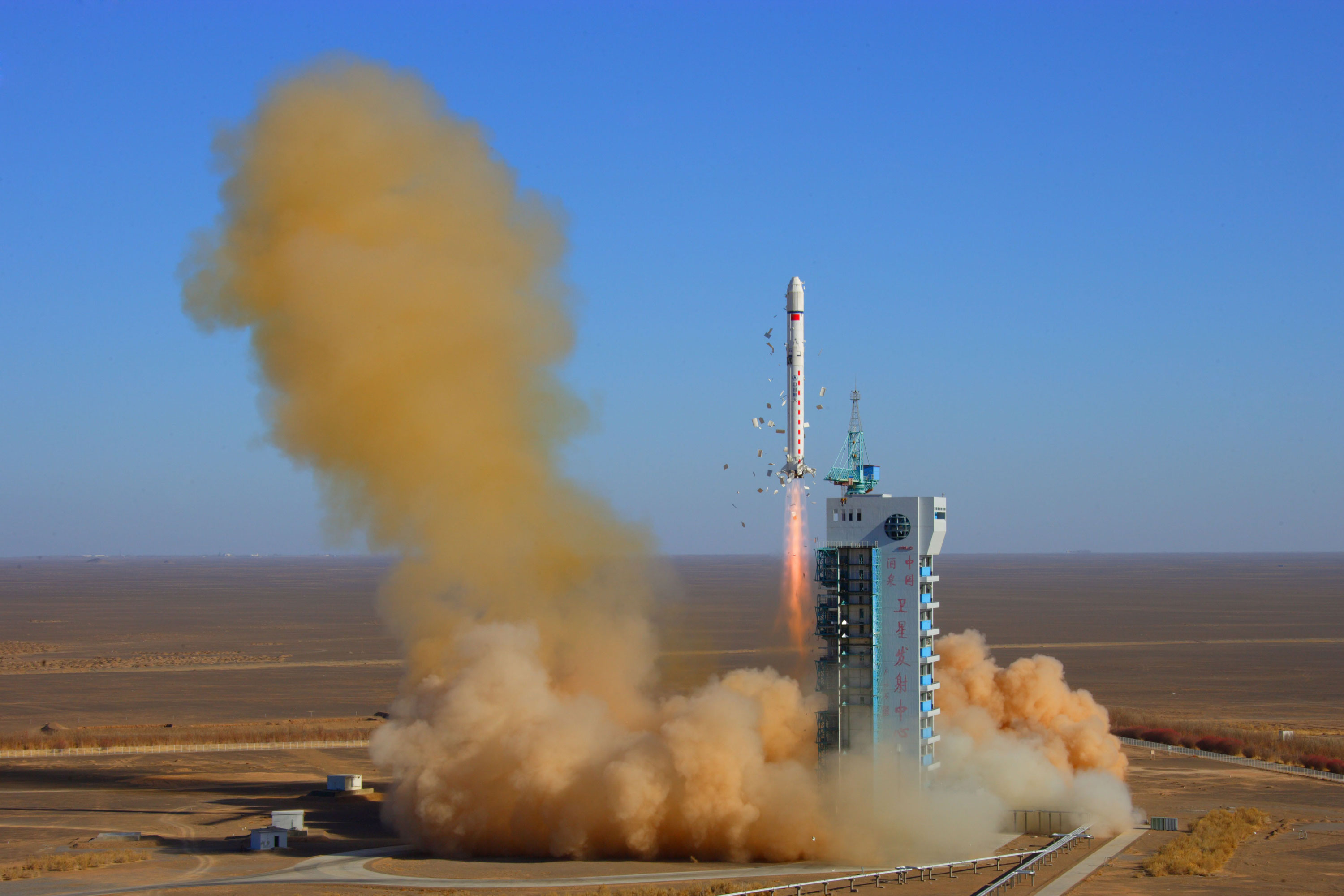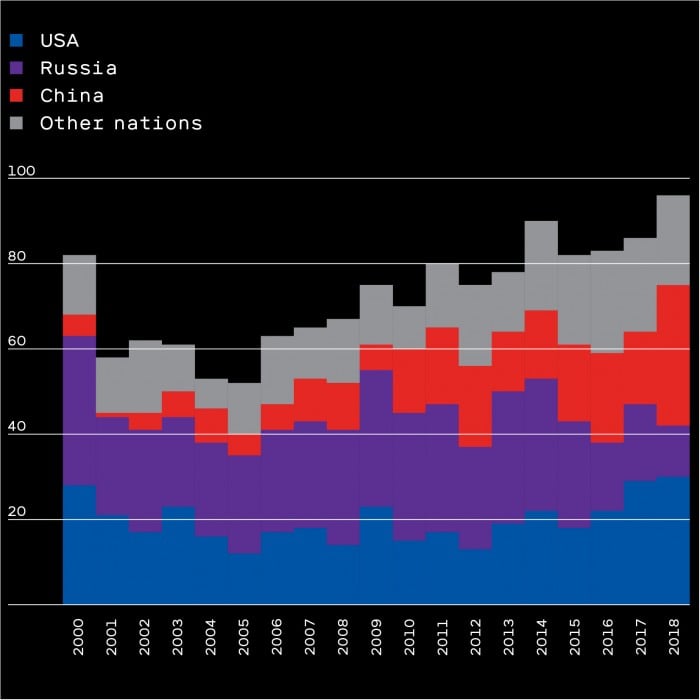China launched more rockets into orbit in 2018 than any other country

Late one afternoon last October, from a remote and desolate launchpad in the Gobi desert, the Future soared into space.
The Future, a small satellite built for a China Central Television science show, was scarcely more capable than the very first Chinese satellite, launched from the same spot, the Jiuquan launch center, in 1970. And yet October’s launch was historic: it was to be the first privately developed Chinese rocket to reach orbit.
Zhuque-1, the rocket carrying the Future to orbit, has three stages. The first stage fired smoothly. So did its second. A few minutes later, the third stage malfunctioned. The Future was lost.
Spaceflight is hard, and failure of new rockets common. SpaceX’s first three launches failed: as its founder and head Elon Musk tells it, the fourth, successful launch came just before money ran out. SpaceX has changed the face of the US aerospace industry. After decades of domination by old-line companies, SpaceX is the most prominent of a new generation of firms that, by dramatically lowering launch costs, seek to revolutionize both human space travel and the satellite launch market.
Now that revolution is coming to China as well. Landspace, the firm that built the Zhuque-1, is not the only firm trying. At the time of this writing, in December 2018, another company, OneSpace, was also planning an orbital launch for later in the year while a third, iSpace, has ambitions for 2019.
Regardless of which company wins the race, two things are clear. Privately funded space startups are changing China’s space industry. And even without their help, China is poised to become a space power on par with the United States.
As American and Russian space programs struggle with uncertain budgets, China is expanding its efforts on every front: communications and reconnaissance satellites; a navigation and positioning constellation to rival America’s GPS; a human spaceflight program; and ambitious space-science and robotic exploration projects. All of these are enabled by a menagerie of new rockets with advanced capabilities.
2018 is shaping up to be the first year in which more rockets reach Earth orbit from China than from any other country. As of mid-December, China had made 35 successful launches, as against 30 for the US.
On December 7 a launch from the Xichang Satellite Launch Center in Sichuan (nearly a thousand miles southeast of the Jiuquan launch center) sent a robotic rover called Chang’e 4 into space. In January it will attempt to land on the far side of the moon. If it succeeds, it will be the first spacecraft to do so: China’s space program is coming of age.
Orbital launches by nation 2000–2018
China’s space program has grown steadily. As of late 2018, China was on pace for nearly 40 orbital launches, more than any other country last year.

By the dawn’s early light
In 2014, the Chinese government decided to allow private investment in space-related industry. Landspace began with a few dozen people. It now has over 200 employees at a manufacturing base in Huzhou in eastern China and at assembly and testing facilities in Xi’an, a central Chinese city. The company plans to work incrementally, beginning with nano-satellites—devices weighing between 1 and 10 kilograms (2 to 22 pounds)—then moving to larger cargoes and, eventually, into human spaceflight.
Space technology will provoke tensions regardless of who holds power. Missiles and satellites are launched the same way.
Landspace already has a contract with a Danish firm to launch a series of nanosize Earth observation and communications satellites into orbit around the equator. Having foreign contracts on the books is important not only because it brings in money, but also as a marker of confidence that China’s space companies are for real.
In September 2018, iSpace launched three nanosatellites on a brief suborbital flight, becoming the first Chinese space startup to successfully get beyond Earth’s atmosphere. Another company, LinkSpace, plans to launch a vertical takeoff, vertical landing rocket in 2020. Landspace, OneSpace, iSpace, LinkSpace, and ExPace (which fashions itself as a startup though it’s a subsidiary of a state-owned enterprise) are the leaders of a bevy of lesser-known Chinese launch startups.
These launch companies are operating hand in hand with a number of new, privately funded Chinese companies that are focused on doing things in space, rather than on getting there. Spacety and Commsat, among others, are planning large constellations of small imagery and communication satellites.
Such constellations—whether Chinese or American—are transforming aspects of the way space is used. By making low-resolution satellite imagery much cheaper to gather (among other novel applications for small satellites), they are catalyzing an era of more nimble commercial, scientific, and military experimentation.
However, human space exploration requires heavy-lift rockets in order to launch space station modules, or to send people back to the moon or on to Mars. You also need heavy-lift rockets to put large communications satellites into geostationary orbit, where they can linger over a particular patch of ground. (Geostationary orbit is about 100 times farther away than low-Earth orbit, and it takes a lot more energy to get there.) And you need them for sample-return missions that aim to bring chunks of the moon or Mars back to Earth.
Payload capacity to low-Earth orbit

Unlike SpaceX, none of the new Chinese space startups are developing such rockets. But China is.
China’s established aerospace industry is an alphabet soup of state-owned enterprises that are the legacies of Russian-style numbered institutions and bureaus from Mao’s days. The largest, Chinese Aerospace Science and Technology Corporation (CASC), is about as big as Boeing—it employs over 140,000 workers. A subsidiary called the China Academy of Launch Vehicle Technology (CALT) built the Long March 5, China’s first heavy-lift rocket. CALT is also working on a super-heavy-lift rocket that, when completed in a few years, might become the most powerful ever built.
The Long March 5’s first flight, in November 2016, was a success. But rocket science is, well, rocket science. More powerful rockets aren’t just a matter of scaling things up: the complexity grows quickly. That first flight had been delayed for years as engineers worked out kinks in the cryogenic engines. Six minutes into the second flight, in July 2017, a turbo pump failed and the rocket crashed into the sea.
A number of China’s ambitious plans are on hold until the Long March 5 starts flying again. If all goes according to plan, its next launch in January 2019 will carry a large, high-capacity communications satellite to geostationary orbit. The following launch, planned for later in 2019, will send Chang’e 5 to the moon—and back. If it succeeds, it will be the first such sample-return mission since the Soviet Union’s Luna 24 brought 170 grams of lunar soil back to Earth in 1976.
China’s next step in human spaceflight will be a large, permanently crewed space station. The launch of the station’s core module by a Long March 5 is planned for 2020, the first step toward a complete station by 2022. Even when complete, China’s space station will be only about a fifth the size of the International Space Station (ISS). But it will be entirely China’s, while the ISS’s future as a US-Russian collaboration (with some assistance from other countries) is in doubt.
China is also developing a space telescope that will have the same resolution as the Hubble—with a field of view 300 times larger. The telescope will be placed in orbit close to the space station, so that Chinese astronauts can quickly service the instrument should problems arise. CALT has learned from NASA’s mistakes—it took over three years for NASA to fix Hubble’s flawed mirror.
Assuming CALT works out the kinks, the Long March 5 will transform China’s space capabilities. The successor CALT is developing, the Long March 9, whose first flight is penciled in for 2028, will be able to heave 140 metric tons into orbit, more than five times as much as the Long March 5. In capacity it will compare to the Saturn V—still the most powerful rocket ever built—and far exceed the most ambitious version of NASA’s Space Launch System (SLS), which is also planned for 2028 (at the earliest). The Long March 9 would be capable of landing a man on the moon, and of launching a Mars sample-return mission.
The SLS and Long March 9 could both be delayed by technical setbacks. Furthermore, SpaceX's Falcon Heavy is currently the world's most powerful rocket by a comfortable margin; it can launch over two and a half times as heavy a payload into orbit as the Long March 5. And the first version of SLS, now planned for 2020, will be more powerful still. American heavy-lift capabilities remain well ahead of Chinese ones. However, where NASA’s plans have shifted with each new administration and struggled to find support in Congress, CALT has had a steady mandate from the Chinese government.
The relationship between the US and China has deteriorated under the Trump administration. But the dual-use nature of space technology will provoke international tensions regardless of who holds power in either country. Missiles and peaceful satellites are launched the same way. Environmental monitoring satellites and military reconnaissance satellites are similar; communications satellites can transmit top-secret orders or provide Wi-Fi to airline passengers. Maneuverable satellites for refueling and repairing other satellites can also be used as weapons against an adversary’s orbital platforms.
The US has spent considerable time trying to figure out how to stymie Chinese space plans. It blackballed China from the ISS; a widely criticized 2011 law prohibits bilateral contact between NASA and Chinese scientists. Such efforts are counterproductive. They isolate the US without acting as a meaningful check on Chinese ambitions. To stay ahead, the US will have to get its own house in order, rather than trying to hobble the competition.
Joan Johnson-Freese is a professor of national security affairs at the Naval War College.
Deep Dive
Space
How to safely watch and photograph the total solar eclipse
The solar eclipse this Monday, April 8, will be visible to millions. Here’s how to make the most of your experience.
The great commercial takeover of low Earth orbit
Axiom Space and other companies are betting they can build private structures to replace the International Space Station.
How scientists are using quantum squeezing to push the limits of their sensors
Fuzziness may rule the quantum realm, but it can be manipulated to our advantage.
Stay connected
Get the latest updates from
MIT Technology Review
Discover special offers, top stories, upcoming events, and more.